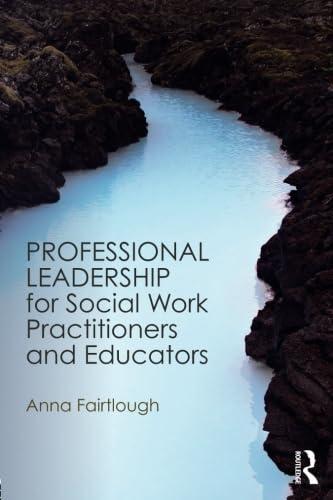In 2000 the national government required local authorities to coordinate the production and implementation of multi-agency policies
Question:
In 2000 the national government required local authorities to coordinate the production and implementation of multi-agency policies and procedures to protect vulnerable adults from abuse and neglect.
This practice example describes how a joint training and development officer initiated use of whole systems methodology, centred around four large-group interventions each attended by 50 to 100 people over a period of nine years, to engage a wide group of agencies and service user organisations in response to this policy demand. The principles of the approach and the design and implementation of the first event are described in Doonan (2002); other information included in this example is drawn from personal communication. Despite continuous personnel change, this officer was able to provide one element of consistent leadership and follow through across an English county during this time. Specialist consultants were employed to support the programme. The multi-agency adult protection (later safeguarding)
board and training sub-group provided a forum to recruit planninggroup members and follow up agreed actions.
Each event had a design team that included the facilitators as well as representatives of the key agencies and service user and carer groups.
People who had a stake in the outcome, important information to contribute or authority to act or commit resources were invited to each event (Doonan 2002). As well as more traditional feedback and actionplanning forms, various methods to record the events were used. For instance, participants were invited to act as ‘roving reporters’, interviewing others about their reactions on the day. Paper tablecloths were used by groups to record words, images and ideas emerging from discussions. At the beginning of one event participants were invited to place a coloured ball in different clear boxes to represent how confident they felt that by working together they could improve the lives of adults experiencing abuse or neglect. They did the same activity at the end.
The difference between the two sets of boxes provided a graphic representation of how people’s belief that they could improve the adult protection system had changed. After one event a CD was produced for community organisations that included key documents, photographs of the materials produced in the event and a quiz to use with community groups.
The first event enabled collaborative consultation on the draft procedures. It used system mapping and voting using coloured sticky dots to identify priorities and future search to imagine a future in which adult protection was working well and identify what needed to be done to achieve this. Outcomes included re-drafted policy and procedures and identification of unresolved issues, such as how NHS disciplinary and complaints processes related to these procedures and the need to engage the police more effectively. The second event reviewed how well the procedures were working two years later. A real case example of a time when the procedures had not worked well was introduced.
Some people who had been involved in this were present. This required everybody in the room to honestly reflect about a painful situation and to focus on system-wide learning rather than be defensive or blame others. Real-time strategic change was used in the first event to develop the procedures and in the second a system-wide evaluation tool. The third and fourth events involved a greater range of service user and carer groups and new organisations such as banks and the post office to enhance awareness of adult safeguarding in the wider community, demonstrating the principle of widening circles of inclusivity. Open-space technology was not used explicitly. However, its principles were embodied in the ways that participants were encouraged in formal sessions and during the breaks to make new contacts and initiate conversations about how they could work together, now and in the future, to improve the lives of vulnerable adults.
Step by Step Answer:

Professional Leadership For Social Work Practitioners And Educators
ISBN: 9781472467539
1st Edition
Authors: Anna Fairtlough





